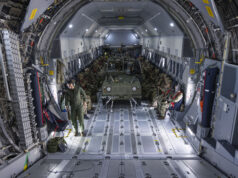More than 120 members of the armed forces, police, and government participated in a national exercise to simulate the UK’s response to a large-scale security emergency, according to a government announcement.
The exercise, Octacine 2, took place from 5 to 7 February 2025, and tested joint responses to extreme national emergencies, such as a major terrorist incident.
The exercise, coordinated by the Home Office, Ministry of Defence, and Counter Terrorism Policing, aimed to strengthen collaboration between military and police personnel. It included simulations of Operation Temperer, the contingency plan established in 2015 to provide military support to police during critical national emergencies.
Armed police officers were temporarily redeployed to respond to simulated security threats, working alongside military personnel across 11 sites in Great Britain. The operation allowed teams to practice rapid deployment, joint briefings, and familiarisation with key sites to ensure coordination during potential real-life incidents.
Security Minister Dan Jarvis highlighted the importance of the exercise: “Exercises like Octacine 2 are vital to ensure that our armed forces and policing partners are able to work well together to protect the British public from ever-present threats. I am grateful for their tireless and dedicated work in serving our country, and their ongoing preparation to perform those critical roles that keep us safe.”
The exercise featured live-play scenarios, simulating the activation of the Operation Temperer national mobilisation coordination centre, which would direct military personnel to assist police efforts during heightened security threats. Operation Temperer covers all of Great Britain and is directed by the National Police Chiefs’ Council Counter Terrorism Coordination Committee.
Minister for Armed Forces Luke Pollard also emphasised the government’s commitment to maintaining national security through proactive preparation: “Our national security is the foundation for this government’s Plan for Change, and exercises like this are critically important to ensure we can respond to threats quickly and effectively. I’d like to thank all members of our armed forces who are held at readiness throughout the year, ready to keep the public and country safe at a moment’s notice.”
The exercise served as a crucial opportunity for personnel to practice coordination and ensure readiness in the event of a major incident. The live-play scenarios not only tested operational efficiency but also provided a visible presence to reassure the public during moments of heightened tension.
The government described Octacine 2 as part of routine counter-terrorism training, which regularly tests the UK’s preparedness for a wide range of security threats, ensuring that police and military units remain well-equipped and capable of rapid response.
At the UK Defence Journal, we aim to deliver accurate and timely news on defence matters. We rely on the support of readers like you to maintain our independence and high-quality journalism. Please consider making a one-off donation to help us continue our work. Click here to donate. Thank you for your support!














Any idea which 11 sites were involved?
Hi bud. There was quite lot of activity around Bacton Gas Terminal at that time, don’t know if it was related to this.
Thanks mate.
I found a ref to the 1st exercise, Octaine, with a ref to Longmoor as well.
They often use Aldwych tube station as well for the CT side.
Just curious, as always.
The mind that never switches off! There is often a convoy of plain white Transits with blue lights heading that way on the A47. Mod Plod and a few others playing Starsky and Hutch lol.
White transits?
Interesting.
Well, I never noticed anything untoward going on at all. Obviously a very low-level exercise
120 people across 11 sites, I’m not surprised.
Ahhh ! The words of the eternal oppressor ‘National security’
❤️☮️
Is it time for the UK to re-introduce a Civil Defence Force to help with national emergencies including, sabotage of infrastructure, floods, storms etc.?
Anyone forsee a Home Service Force being recreated? There are not enough service personnel and if war with Russia is looming, having willing volunteers who know the drill and who don’t need the level of high weaponry the regs use might be an idea worth considering. Thoughts?
Requires both an ex military home service force and a civil defence corps neither need be very large nor expensive but can be the cadre for emergencies.